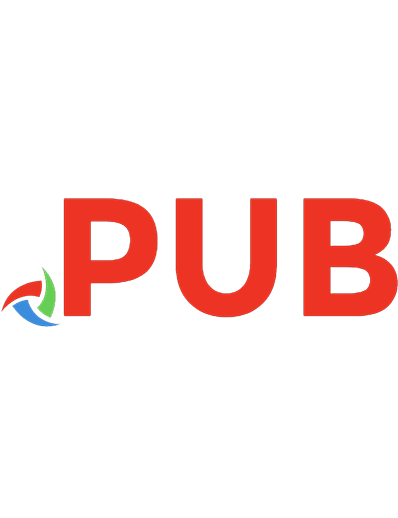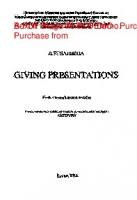Projects and Presentations 0716632225, 9780716632221
438 111 17MB
English Pages [136] Year 1986
Polecaj historie
Citation preview
ROOSEVELT MIDDLt bWIUUl LIBRARY
PROJECTS
AND PRESENTATIONS
THE
WORLD BOOK
Volume
6 PROJECTS
AND PRESENTATIONS
Published by
World Book, a Scott Fetzer
Inc.
company
Chicago
ROOSEVELT MIDDLE SCHOOL LIBRARY
28121
b)
V-U
2'
281 Staff
ROOSEVELT MIDDLE SCHOOL 460 ARGUELLO BOULEVARD 94118 SAN FRANCISCO. CA.
67669
Product Production
Publisher William H. Nault Editorial
Executive Director Peter Mollman
Editor in Chief Robert O. Zeleny
Joseph
Executive Editor Dominic J. Miccolis
Research and Development Henry Koval, manager
Associate Editor Maureen M. Mosryn
Jerry Stack, director
Senior Editor Michael K. Urban
Manufacturing C. La
Count, director
Pre-Press Services Randi Park Sandra Van den Broucke
Proofreaders Writer
Marguerite Hoye, head
Kathleen
L.
Florio
Production Editor
Ann Dillon Esther Johns Daniel Marotta
Elizabeth Ireland
Index Editor Joyce Goldenstern
Permissions Editor Janet T. Peterson
Editorial Assistant Elizabeth Lepkowski
Copyright
©
World Book,
Art
1986 by Inc.
Merchandise Mart Plaza Illinois 60654
Chicago,
Executive Art Director William
Hammond
All rights
may
Designers Tessing Design,
or Inc.
Photography Director John
S.
reserved This volume
not be reproduced
in
whole
any form without written permission from the publishers in part in
Printed in the United States of America
Marshall ISBN 0-7166-3190-3 (Volume 6) ISBN 0-7166-3184-9 (set)
Photographers Don Sala
Library of Congress Catalog No. 86-50558
Jim Ballard
a/hi
—
Contents
Introduction
7
Section I Presenting Your Project and Yourself
8
Section
II
Developing Your Project Section
14
III
Rehearsing Your Presentation
48
Section IY
Making Your Presentation
78
Section V Ideas for School Projects
90
Section VI Attention Getters
Index
112 124
Acknowledgments
The anecdote on Inca ruins
that
appears on pages 116-117 was
adapted from Secrets of the Past by
©
Gene
S.
Stuart, copyright
1979, National Geographic Society.
The quotation from 122
is
Carl Sagan that appears
from Cosmos by Carl Sagan, copyright
Sagan Productions,
Inc.
Inc.
New
on pages 121—
1980 by Carl
Reprinted by permission of the author
and the author's agents, Scott Meredith Third Avenue,
©
York,
New York
Literary Agency, Inc.,
10022 and
845
Random House,
Introduction From time
to time in school
you are called upon
to create
a special project or to deliver an oral presentation as part
of your classwork. Such a situation provides you with an
opportunity to be creative and to share what you learn with your fellow classmates. Projects tells
you
how
effectively to
and Presentations
to put together projects
and present them
your audience.
The first section of this volume explains why projand presentations are an important part of your school work. It also describes the types of skills that you develop by performing such assignments. The second section gives helpful information on developing your project, from analyzing your audience to making props and using ects
audio-visual aids.
Section
III
helps you rehearse your presentation.
It
and gives a step-by-step Section IV tells you what to
offers various delivery techniques
approach to your rehearsals. do on the day of your presentation. Helpful hints explain how to handle stage fright, audience reaction, and unexpected problems.
The tains
fifth
more
projects.
section of Projects
and Presentations
con-
than 100 ideas that you can use for school
There are suggestions
for each
major area of
study: social studies, science, language arts, final section
of this volume explains
ence's attention and hold
it
how
and math. The your audi-
to get
by using helpful speaking deand star-
vices such as anecdotes, quotations, questions, tling facts.
Before you begin your next class project or presenvolume. You will get the extra help
tation, consult this
order to make your assignment a success benefits both you and your schoolmates.
you need
in
that
PRESENTING YOUR PROJECT—AND YOURSELF mi^mmmi
&m This section explains the purpose of creating projects and presentations and the skills you will need to develop in order to carry out these assignments. The Purpose of Your Project
10
The Long-Term
1
Benefits
Vesmmm
—
—and Yourself
Presenting Your Project
Presenting Your Project and Yourself
A
5
a student, your day-to-day school learning is shaped in many ways. You spend
experience
time reading textbooks, listening to teacher
lectures,
participating in class discussions, doing in all sorts of other
homework, and taking part learning
activities.
Some of the most
challenging of
these learning activities involve projects
and
presentations.
—
ject
Doing a project means creating something an obmake a model or
or an event. For example, you might
a diorama, sculpt a figure,
demonstrate a folk dance, or
dramatize a scene from a story.
Presentations are the
means by which you share your project with your classmates or some other audience. In most cases, you simply stand in front of the class to present your project. At other
group outside your for example. Sometimes, as in dramatic reading, the presentation and the project are the same thing. Projects and presentations fit into the school routine in a variety of ways. They may be assigned to everyone in the class as part of the regular curriculum. Your social studies teacher, for example, may ask you and your classmates to do projects as you study a unit on Latin America. Sometimes you do a project either assigned or voluntimes,
you present your project to
classroom
tary
—
a
—other students or parents,
—
for a special school activity,
You may do
from tumbling. together
on
such as a science
fair.
a project for extra credit to help save a grade
On
certain occasions, your class
a project that will
be presented
may work
as a
program
for parents or the entire school.
The Purpose of Your Project Doing a project and preparing considerable amount of time.
10
It
a presentation can take a is
time well spent, how-
I
because
ever,
in the
For many
handy both
Helping
in
a
lot
offun
to do.
process you are gaining knowledge,
tapping your creativity, and developing in
students, projects are
skills that will
come
and out of school.
You Learn
Even the best teachers cannot give you
all
the information
would like to about certain topics. There just is not enough time. Projects give you and your classmates a chance to learn more than what can be taught in the limited amount of time your teacher spends with you each
they
does not stop when you step out of the classroom, and doing a project is a form of independent study learning on your own. When it is your turn to present your project, you are giving your classmates information they may not have known before. As you listen to your classmates present their projects, you are learning from their experience and effort. In this way, each of you conday. Learning
—
tributes to the overall learning process.
Projects can
be
particularly effective learning tools,
because they make you, the student, an active participant in the learning process. In
many
cases, projects involve a
hands-on approach to learning. For example, instead of just reading in your science textbook about the properties of air, you can set up a demonstration showing that air weighs
something or
that hot air rises.
reading or listening, you are
By doing,
more
instead of just
likely to
remember
what you have learned.
Tapping Your Interests and Creativity For
many
students, projects are a lot of fun to do.
They
give you a chance to pursue a special interest or satisfy a
Perhaps you are interested in drama, and you out what theaters looked like in Shakespeare's time. Building a model of the Globe Theatre
curiosity.
would
like to find
might be an acceptable project for your English an enjoyable experience
at
the
same
class
and
time.
Because many projects involve a creative process, they frequently give you a chance to put special talents or
11
Presenting Your Project
—and Yourself
hobby
skills to
good
use. If
you love
to
work with
clay, for
example, and you are studying American Indians in your social studies class, a project assignment might mean a
chance to create a bowl or a pitcher
in the style of the
Zuni
Indians.
Skills
You
Will Develop
and the fun involved in doing and presentations, you will develop a number of important skills in the process. These include the skills
In addition to the learning projects
necessary to do research, to organize information, to speak
before a group, and to
work
cooperatively with others.
Research Skills As you plan and create a project, you will develop research
You cannot
build a model of the Globe Theatre or bowl without first finding out what those things look like. Your project may lead you to the library skills.
create a Zuni
to find information or to other sources that can provide
you with the
facts
you need.
Organizing Skills As you prepare for the presentation of your project, you need to organize the facts at hand so that you can present
them
in a
can follow
way
makes sense and that your classmates These organizing skills are an important
that
easily.
part of a successful presentation.
Speaking Skills
When you present your one of your main purposes is to share what you have
project,
learned with your audience.
12
Making a presentation involves another set of skills speaking skills. When you present your project, one of your main purposes is to share what you have learned with your audience. You need to convey your message clearly and keep the audience's attention from start to finish. To do that, you must employ the techniques of effective public speaking. Learning how to speak in front of a group involves more than just saying words, however. It also means having poise and self-confidence. In that sense, you are
Projects to
I
and presentations add a
your school
presenting yourself, as well as your project, stand up to
make your
special dimension
life.
when you
presentation.
Socialization Skills you are doing a group
you have an opportunity needed for successful cooperation. Working as part of a group is different from preparing a project and presentation on your own. It calls for sharing ideas, dividing responsibilities, and doing your part If
to
project,
develop the socialization
skills
to assure that the final effort succeeds.
The Long-Term Benefits When your school years are behind you, you may not remember every project and presentation you made as a student. But the skills
you
you developed can continue
to serve
in various ways.
The student who was able to think of a good project gathered and organized the necessary information, and then presented it effectively may grow up to be the adult who is asked to take on additional job responsibilities and leadership roles. In many career areas, success depends on creative thinking, diligent research, and self-conidea,
fident presentations.
These same volved
member
group. Knowing to finish
is
skills
can help you
become an
active, in-
of a civic organization or a community
how
to carry
through a project from
start
an asset whether you are planning a PTA fund-
raiser, organizing a neighborhood movement for improved community services, or working to elect a political candidate. Communicating with poise and confidence enhances
your involvement even
further.
and presentations add a special dimension to your school life by allowing you to express yourself in a variety of ways. They allow you to be creative and resourceful and to interact with others. Take advantage of the opportunities they present. Learn from them, enjoy doing them, and remember that the skills they help you develop Projects
can provide lifelong benefits.
13
DEVELOPING YOUR PROJECT This section tells you how to lay the groundwork for successful projects and presentations. Planning for Success
Choosing
a Project
Analyzing Your Audience
Determining the Purpose
Doing Research Organizing Your Presentation
Props and Audio-Visual Aids
Group
Projects
Keeping on Track
* A******
|IMKH>


![The World Book Learning Library Vol. 6: Projects and Presentations [6]](https://dokumen.pub/img/200x200/the-world-book-learning-library-vol-6-projects-and-presentations-6.jpg)




![(Re)presentations and Dialogue [1 ed.]
9789027273161, 9789027210333](https://dokumen.pub/img/200x200/representations-and-dialogue-1nbsped-9789027273161-9789027210333.jpg)


